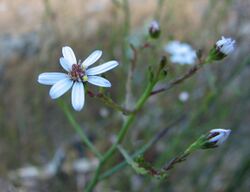Biology:Olearia suffruticosa
| Olearia suffruticosa | |
|---|---|

| |
| In the Royal Botanic Gardens Melbourne | |
| Scientific classification | |
| Kingdom: | Plantae |
| Clade: | Tracheophytes |
| Clade: | Angiosperms |
| Clade: | Eudicots |
| Clade: | Asterids |
| Order: | Asterales |
| Family: | Asteraceae |
| Genus: | Olearia |
| Species: | O. suffruticosa
|
| Binomial name | |
| Olearia suffruticosa D.A.Cooke[1]
| |
Olearia suffruticosa, commonly known as clustered daisy-bush,[2] is a species of flowering plant in the family Asteraceae and is endemic to south-eastern continental Australia. It is a shrub or undershrub with scattered, linear, grass-like leaves and pink to white and yellow and pink, daisy-like inflorescences.
Description
Olearia suffruticosa is sticky shrub or undershrub that typically grows to a height of 40–70 cm (16–28 in) and has a woody base and slender, short-lived glabrous stems wth few branches. The leaves are arranged alternately, sessile, linear and grass-like, 3–24 mm (0.12–0.94 in) long and 0.5–0.9 mm (0.020–0.035 in) wide and more or less glabrous. The heads or daisy-like "flowers" are arranged in leafy panicles on the ends of branches, on a peduncle up to 50 mm (2.0 in) long, each head with a bell-shaped involucre at the base. Each head has 12 to 20 white to pink ray florets, the ligule 7–8 mm (0.28–0.31 in) long, surrounding 16 to 22 yellow and pink disc florets. Flowering occurs from January to May and the fruit is an achene about 1 mm (0.039 in) long, the pappus about 2 mm (0.079 in) long.[2][3][4][5][6]
Taxonomy
Olearia suffruticosa was first formally described in 1985 by David Alan Cooke in the Journal of the Adelaide Botanic Gardens from specimens collected near the Bool Lagoon in 1963.[5][7] The specific epithet (suffruticosa) means "somewhat woody".[8]
Distribution and habitat
Clustered daisy-bush grows in heathland in swampy areas in the far south-east of South Australia, the south-west of Victoria near Glenisla, Casterton and Dergholm, and between Capertee and Wallerawang in New South Wales.[2][3][4][9]
Conservation status
This olearia is listed as "endangered" under the Victoria Government Flora and Fauna Guarantee Act 1988[3] and as "vulnerable" in the Department of Sustainability and Environment's Advisory List of Rare Or Threatened Plants In Victoria.[9][10]
References
- ↑ "Olearia suffruticosa". Australian Plant Census. https://biodiversity.org.au/nsl/services/apc-format/display/106882.
- ↑ 2.0 2.1 2.2 Lander, Nicholas S.. "Olearia suffruticosa". Royal Botanic Garden Sydney. https://plantnet.rbgsyd.nsw.gov.au/cgi-bin/NSWfl.pl?page=nswfl&lvl=sp&name=Olearia~suffruticosa.
- ↑ 3.0 3.1 3.2 Lander, Nicholas S.; Ohlsen, Daniel. "Olearia suffruticosa". Royal Botanic Gardens Victoria. https://vicflora.rbg.vic.gov.au/flora/taxon/6a60d7fc-62a6-4814-bc78-7bf99dcbe091.
- ↑ 4.0 4.1 "Olearia suffruticosa". State Herbarium of South Australia. http://www.flora.sa.gov.au/cgi-bin/speciesfacts_display.cgi?form=speciesfacts&name=Olearia_suffruticosa.
- ↑ 5.0 5.1 Cooke, David A. (1985). "Studies in the Tribes Astereae and Inuleae (Compositae).". Journal of the Adelaide Botanic Gardens 7 (3): 279–280. https://www.jstor.org/stable/23874589. Retrieved 16 August 2022.
- ↑ Wild Plants of Victoria (database). Viridans Biological Databases & Department of Sustainability and Environment. 2009.
- ↑ "Olearia suffruticosa". https://biodiversity.org.au/nsl/services/rest/name/apni/537060/api/apni-format. Retrieved 16 August 2022.
- ↑ Sharr, Francis Aubi; George, Alex (2019). Western Australian Plant Names and Their Meanings (3rd ed.). Kardinya, WA: Four Gables Press. p. 317. ISBN 9780958034180.
- ↑ 9.0 9.1 Corrick, M.G.; Fuhrer, B.A. (2001). Wildflowers of Victoria and adjoining areas. Australia: Bloomings Books. ISBN 1876473142.
- ↑ "Advisory List of Rare Or Threatened Plants In Victoria - 2014". Department of Sustainability and Environment (Victoria). p. 33. https://www.environment.vic.gov.au/__data/assets/pdf_file/0021/50448/Advisory-List-of-Rare-or-Threatened-Plants-in-Victoria-2014.pdf. Retrieved 16 August 2022.
Wikidata ☰ Q7086011 entry
 |

